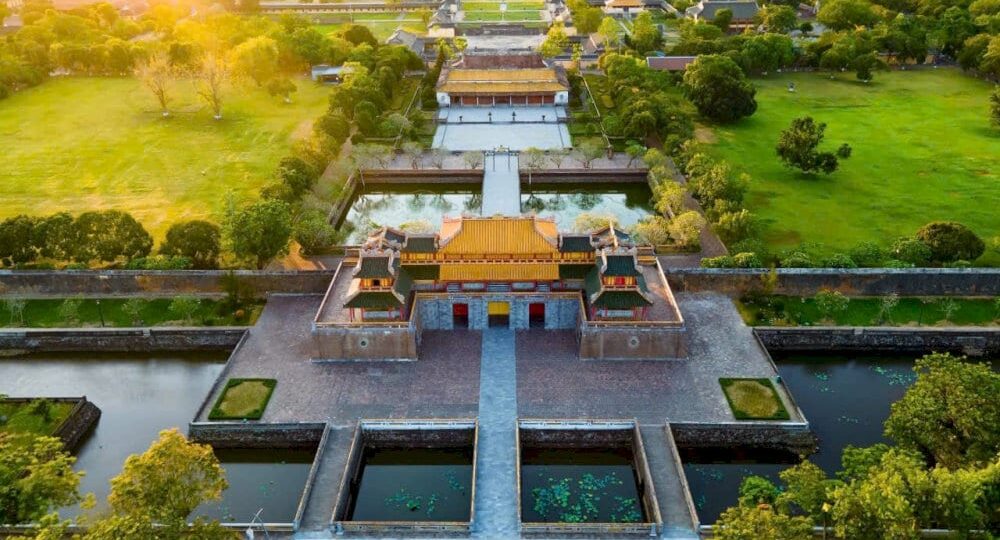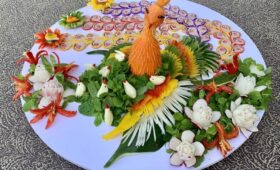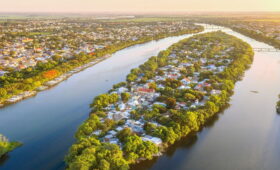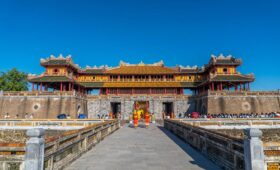Detailed Travel Guide To Explore Hue Vietnam Imperial City
1. Overview:
Hue Vietnam Imperial City is considered the cultural and historical soul of Vietnam, located on the poetic Perfume River, and was the place of rule of the Nguyen Dynasty from 1802 to 1945. Today, this place is recognized by UNESCO as a World Cultural Heritage, attracting millions of domestic and foreign tourists to admire.
The majestic architecture, the harmony between Asian feng shui and royal art, and the rich history have turned Hue Citadel into a destination not to be missed when traveling to the Central region.
2. History of Hue Vietnam’ Imperial City
The Hue Citadel is associated with the Nguyen Dynasty—the last feudal dynasty of Vietnam. In 1803, King Gia Long began planning, and in 1805, he mobilized 30,000 workers to start construction of major projects such as river barriers and trenches.
In 1809, 10 gates were built, creating a clear defense system. By 1818, the number of workers increased to 80,000 people to tile the four sides of the East-West-South-North citadel. Under the reign of Minh Mang (1831 – 1832), the outer wall system continued to be completed, strengthening the defense.
After nearly 30 years, Hue Vietnam Imperial City, has not only become the political, administrative, and military center but also a symbol of the power, culture, and history of the Nguyen Dynasty.

Images of Hue Imperial City in the past. (Source: internet)
3. Unique architecture of Hue Vietnam Imperial City
Hue Vietnam Imperial City has a nearly square plan, the front is slightly curved like a bow to hug the winding Perfume River. The project has an area of about 5.2 km², the perimeter of the citadel is 10,571 m long, 21.5 m thick and 6.6 m high.
The citadel was built in the style of the French Vauban citadel with 24 bastions protruding outward, cleverly combining traditional Eastern architecture. Thanks to the flexible application of the terrain, this place has become a unique masterpiece of military architecture, both having defensive value and being an artistic and historical symbol of the Nguyen Dynasty.
The structure of the project consists of 3 main citadels, creating the most solid and large-scale protection system in Vietnam.

Overview of Hue Imperial City (Source: internet)
3.1. The gates of Hue Citadel
The outer wall of Hue Vietnam Imperial City, has a total of 13 entrances, including 11 road gates and 2 waterway gates. The most prominent of these is Ngo Mon (South Gate)—the main gate associated with many important ceremonies of the Nguyen Dynasty.
In the South, there is also the Southeast Gate (Thuong Tu) associated with the Thuong Tu Courtyard, the Nhon Gate, which once housed cannons, the Quang Duc Gate, which collapsed in the flood in 1953 and was then restored, and the Nha Do Gate near the Thuong Ty office.
The West includes the Right Gate (Southwest)—where King Ham Nghi left the citadel in 1885, the Chanh Tay Gate—the site of fierce fighting in 1968, and the An Hoa Gate (Northwest) connecting the market and the ancient village of An Hoa.
The North has the Hau Gate (Chanh Bac), which was closed for more than a century before reopening in 2004.
To the east are the Ke Trai Gate (Northeast) and Dong Ba Gate (Chanh Dong), which witnessed many fierce battles.
In addition, the system also has Tran Binh Mon—an internal gate connecting the defensive fortress—along with two water gates: Tay Thanh (1826) and Dong Thanh (1830) to regulate water and transport goods.
Today, the 13 gates of the citadel not only have military and architectural value but are also unique historical highlights, attracting visitors.

Ngo Mon Gate is the main gate leading to the Imperial City, located in the center of Hue Citadel. (Source: internet)
3.2. Imperial Citadel
The Imperial Citadel is the second citadel of Hue Citadel, serving as the administrative, ceremonial, and living center of the king and royal family. This is also the place to worship ancestors and Nguyen Dynasty kings. The Imperial Citadel began construction in 1804 under King Gia Long and was completed in 1833 under King Minh Mang.
The Hue Imperial Citadel has 4 gates, including the main gate, Ngo Mon. Inside the Imperial Citadel is a system of important palaces, towers, and temples, such as Thai Hoa Palace, Dien Tho Palace, Hien Lam Pavilion, etc.
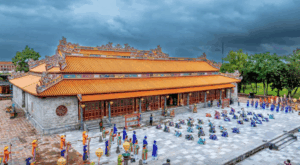
Thai Hoa Palace was once the official court of the Emperor (Source: Internet)
3.3. Purple Forbidden City
The Purple Forbidden City is the innermost citadel, located deepest in the Hue Imperial City area, and was once the place where the king and royal family lived and worked. The construction began in 1803, and it was officially named the Purple Forbidden City in 1821, under the reign of King Minh Mang.
The Purple Forbidden City of Hue Citadel was designed in a rectangular shape, with the front being the main gate, Dai Cung Mon. Inside the citadel, there are still many important relics, such as Duyet Thi Duong, Dien Can Chanh, Dien Can Thanh, and Vac Dong, etc.
4. Royal culture and art at Hue Vietnam Imperial City
Besides its historical value, Hue Vietnam Imperial City, is also a center for preserving the culture and art of the Nguyen Dynasty, which has been recognized by UNESCO as an intangible cultural heritage of humanity. When setting foot in the Dai Noi Hue (including the Imperial City and the Forbidden City), visitors not only admire the ancient structures but also have the opportunity to learn about the spiritual life of the ancient royal family.
4.1. Hue Royal Court Music (“Nhã nhạc Cung đình Huế”)
The most prominent is Hue Royal Court Music, a type of classical music that was played in important ceremonies, ceremonies to worship heaven and earth, or banquets to welcome ambassadors. The sound of royal music combined with graceful royal dance creates a solemn atmosphere, helping visitors feel like they are attending a royal ceremony.
Nowadays, visitors can enjoy Nha Nhac right at Duyet Thi Duong in Dai Noi Hue and on dragon boats on the Perfume River, especially lively during the Hue Festival, which takes place every two years.
Duyet Thi Duong (inside Dai Noi Hue)
- Time: 10:00–10:30; 15:00–15:30
- Ticket price: 8 USD/ticket
Hue Royal Court Nhac on the Perfume River
- Time: 19:00–20:00; 20:00–21:00
- Ticket price: 4 USD/ticket

Hue Royal Court Music – One of the intangible cultural heritages of humanity. (Source: Internet)
4.2. Royal Court Restoration Performing Arts
In addition to Nha Nhac, visitors can also enjoy many programs recreating royal court rituals such as the Ban Soc ceremony (annual calendar distribution), the Nam Giao ceremony, or the procession in the Imperial City. These activities are held periodically throughout the year, peaking during the Hue Festival or important anniversaries of the ancient capital.
Experiencing these royal court arts not only vividly recreates the image of the ancient royal palace but also affirms Hue as the cradle of the unique culture of Vietnam.
5. Experience of visiting Hue Vietnam Imperial City
5.1. Location, opening hours, and ticket prices of Hue Citadel
The Hue Citadel is located on the north bank of the Perfume River, bordered by Tran Hung Dao and Le Duan streets to the south, Tang Bat Ho and Dao Duy Anh streets to the north, Phan Dang Luu and Huynh Thuc Khang streets to the east, Le Duan streets to the west.
- Address: 23/8 Street, Phu Xuan Ward, Hue City, Vietnam.
- Entrance fee for reference:
Adults: 8 USD/person
Children (7-12 years old): 1.5 USD/person
Visitors can also choose to use the Hue Imperial City tour guide service with an additional fee of 5.69 USD/tourist.
- The opening hours of Hue Imperial City vary by season:
Summer: 6:30 – 17:30
Winter: 7:00 – 17:00

The beauty of Hue Imperial City Vietnam at sunset. (Source: interset)
5.2. Best time to visit Hue Imperial City Vietnam
January to March (spring) and April to June are the two most ideal times for tourists to visit Hue Citadel.
In spring, Hue’s weather is cool, with little rain, not too hot, and suitable for outdoor tourism activities.
From April to June is the festival season in the ancient capital; this is also the time of the Hue Festival. Therefore, visiting Hue Citadel at this time, you will have the opportunity to immerse yourself in the vibrant festival atmosphere and learn more about the unique culture of Hue.
5.3. How to get around Hue Citadel
The Hue Citadel is quite large, so visitors have many options to visit:
Walking: Suitable for admiring the ancient space and taking vivid photos. However, it takes quite a lot of time if you want to visit all the places.
Bicycle: Tourists can rent bicycles at tourist shops for 2 – 3.04 USD/day, convenient and flexible.
Cyclo: A typical experience of Hue, priced at about 8-10 USD/hour, sightseeing and listening to historical stories from the driver.
Electric car: A comfortable choice for groups or families, priced at about 11.39 USD/trip/maximum 7 people, saving time traveling between points.
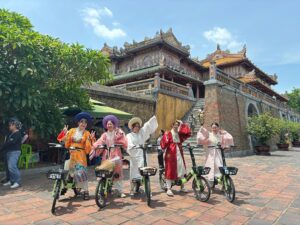
Riding a GCOO electric bike to explore Hue Imperial City is a new and exciting experience. (Source: Khám phá Huế)
5.4. Cuisine near Hue Vietnam Imperial City
After your exploration, stop by the restaurants near the Imperial City to taste the quintessence of Hue cuisine. Spicy Hue beef noodle soup (bún bò Huế) , rustic mussel rice, or the delicious trio of banh beo, nam, and loc will bring you an unforgettable culinary experience.
Some suggested restaurants and eateries you can refer to:
- Hanh Restaurant: famous for its mussel rice, banh beo, and banh nam, just a few minutes’ walk from the Imperial Citadel.
- Cung Dinh Restaurant: specializes in serving Hue royal dishes in a luxurious space.
- Me Le Restaurant: a long-standing address with traditional Hue beef noodle soup flavor.
- Les Jardins de La Carambole: a prominent French-Vietnamese restaurant, close to the Imperial Citadel, and has a classic space.
- Ba Do Restaurant: famous for its Hue-style banh beo chen, banh bot loc, and banh nam.
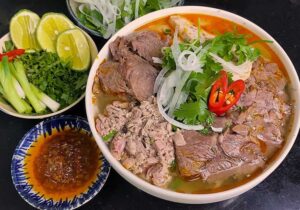
Hue beef noodle soup – A specialty imbued with the identity of the ancient capital. (Source: Internet)
5.5. Staying near Hue Vietnam Imperial City
To make your visit to Hue Citadel more complete, choosing a hotel near the center is the perfect choice. Some outstanding hotel suggestions you can refer to:
- Azerai La Residence Hue: a luxury boutique hotel on the banks of the Perfume River, famous for its ancient French architecture and classy service.
- Saigon Morin Hotel: a hotel with historical imprints from the French colonial period, ancient space, and a central location.
- White Lotus Hue Hotel: modern style, with a sky bar overlooking the city and Perfume River at night.
6. Conclusion
Hue Vietnam Imperial City is a must-see destination when visiting Hue. With this useful guide, you have all the information you need to fully explore the wonders here.
To make your trip more complete and convenient, let Asia Luxury Travel accompany you on your journey to discover Hue. Contact us today to book a tour and experience Hue Imperial City in the most classy, profound, and memorable way!
7. Contact :
Phone: +84 965 721 426
Email: sales@asialuxurytravels.com
Website: https://asialuxurytravels.com/
Address: No. 9, Alley 31/7, Phan Dinh Giot Street, Thanh Xuan, Hanoi

